Marriage in Ancient Egypt
Although some aspects of marriage in ancient Egypt were similar to those of today, others were radically different, and other aspects remain hazy. As in today's society, Egyptians considered marriage to be for a lifetime but divorces were fairly common. Incest was frowned upon except for royalty, who could marry their siblings, and marriages were expected to be monogamous, except for royalty.
Boys were usually married by the age of 15 to 20 while girls married at a younger age, sometimes as early as 12 years old. Since the average lifespan was about 30 years, these ages probably did not seem as young to the Egyptians as they do today.
Romantic Love in Ancient Egypt
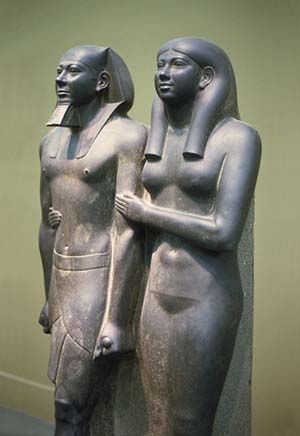
© MCAD Library - Pharaoh Menkaure and his wife
Many ancient Egyptian tomb drawings depict affectionate gestures between a man and wife, indicating that there was an emphasis on romantic love in ancient Egypt. Common images depict couples touching each other, caressing each other, offering gifts, and smiling. King Tut's tomb contains numerous romantic images of himself and his wife, Queen Ankhesenamun, engaged in romantic gestures.
Although the primary considerations for life partners were quality of lineage, personal integrity, and personal habits, many couples also opted for romantic love in their relationship. Men and women endeavored to make their spouses happy because it was thought that their marriage would extend beyond the grave, and no one wanted to be miserably married for eternity.
More emphasis was placed on the woman's happiness than the man's. A man was expected to provide for his wife in a manner that would please her and ensure her happiness. In return, she was expected to happily provide a neat and clean household that ran smoothly, to keep herself neat and well groomed, to provide children who were well mannered, and to be content. For the husband, this meant that even if he wasn't passionately in love with his wife, he could be content and happy.

© Wally Gobetz - Statue of a New Kingdom couple
Many poems have survived which glorify the concept of romantic love, including posthumous loving odes from a grieving husband to his wife. Apparently, romance wasn't always the answer though. The works also include frustrated pleas from widowers imploring their departed wives to stop tormenting them from beyond the grave.
Since wives were considered equal to their husbands in ancient Egyptian culture, it was important to select a compatible and congenial wife. Although men were considered the masters of their homes and the women and children were to obey him, the women were not considered subordinate to their husbands.
Men were expected not to micromanage their household, that was the wife's domain, and to leave her in peace and quiet if she was satisfactorily performing her wifely duties.
Chastity before marriage was not considered important, the ancient Egyptians considered sexuality to be a part of life, nothing more or less. Single adults were free to copulate with others and illegitimacy carried no stigma. This helped the ancient Egyptians to ensure compatibility on all levels with their life partner and reduced the number of divorces.
Marriage Ceremony
Unlike today, there were no requirements for a legal ceremony for a marriage. When a couple decided to marry, or their parents decided for them, the bride gathered her belongings and moved them into the groom's house, whereupon they were considered to be married.
When a man took a woman to wife, it was understood that he had his own household; men didn't marry until they could afford to live on their own. They didn't marry and then continue to live with his or his wife's parents. This indicated that the man was sufficiently responsible to provide for his wife and future children, and that he cared for their well being.
Usually, documents were drawn up that detailed items specifically belonging to the wife and those items that the husband was bestowing upon her, but there were no documents required stating that the couple was married. Apparently, the bride moved her belongings to the groom's house, there was often a celebration, and then they were considered married.
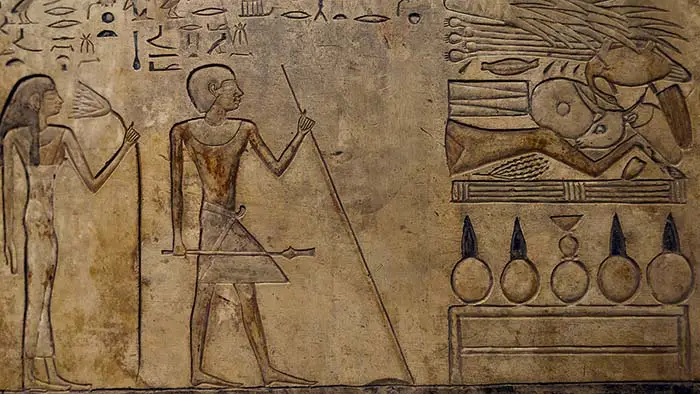
© Darren Puttock - Relief of Meru and his wife
Marriage Agreements/Contracts
Except for the very poor, a marriage in ancient Egypt usually had a contract or agreement that was similar to a modern prenuptial agreement. This document specified the bride price, which was in essence a reverse dowry; that is, the amount the groom's family paid to the bride's family for the privilege of marrying her. It also specified what would be paid to the wife in the event the husband divorced her.
The agreement also specified the items that the bride brought into the marriage and what she would take with her in the event of a divorce. Children always belonged to the mother and they would go with her if there was a divorce, regardless of who terminated the marriage. Egyptian marriage contracts tended to ensure that the ex-wife was not left destitute.
The agreement was compiled by the bride's father and then signed in the presence of witnesses; this constituted a marriage contract and was usually the only documentary evidence of a legal marriage.
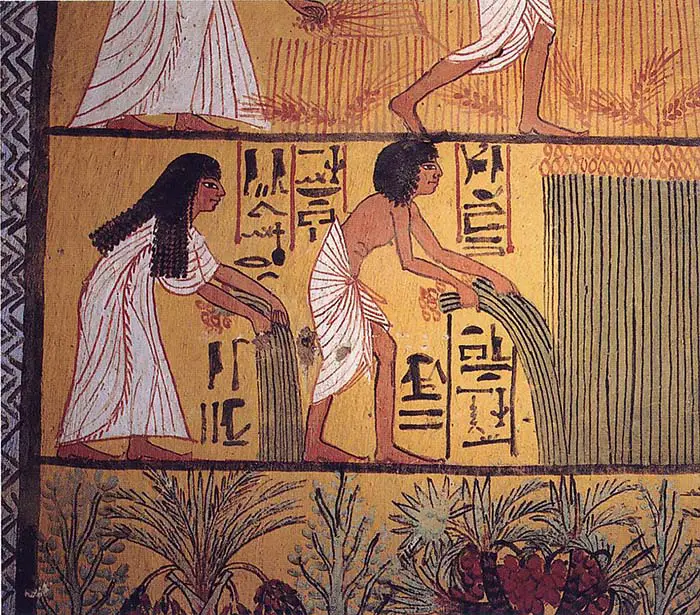
Depiction of a couple during harvest
Divorce in Ancient Egypt
Divorcing a spouse in ancient Egypt was as simple as the process of marrying one. There were no protracted legal proceedings, the terms of the marriage were clearly specified in the marriage contract and generally adhered to.
The exception to this was in the instance of the wife's infidelity. Wives were expected to be faithful to their husbands and those who weren't, if it could be proved, sometimes were put to death, either by stoning or by being burned at the stake. This was not always the husband's decision; the court could overrule a husband who wanted to spare his wife, in which case she was executed.
Egyptian divorces frequently stipulated that spousal support be paid to the wife until she remarried. Unlike today, spousal support was always paid from the husband to the wife. Men had the majority of the wealth in ancient Egypt, except for women who had inherited wealth, and the man usually paid spousal support to the wife, whether the couple had children or not. The wife also kept the dowry provided by the groom at the time of the marriage.

© Richard White - Relief of Isis and Osiris
Marriage and the Afterlife
Marriages were thought to be eternal so the ancient Egyptians placed emphasis on selecting a compatible life partner. The prospect of reuniting with one's spouse in the afterlife was thought to ease the pain of his or her passing. The concept of eternal marriage provided the impetus to make life pleasurable, both on earth and in the afterlife, so that the eternal marriage could be happy and successful.
Ancient Egyptians thought that after death, mortal beings stood before Osiris, who judged them. If their lives were deemed worthy, they were permitted to enter the Field of Reeds, where their earthly lives would continue on a higher plane. All the possessions and those who were held dear would be waiting, such as one's spouse, pets, home, relatives, and so forth.
If the deceased had mistreated others and not lived a good life, then this reunion might not occur and the deceased could suffer consequences in subsequent lives. Poems, inscriptions, and documents exist that indicate a surviving spouse thought his or her departed was exacting revenge from his or her place in the afterlife.
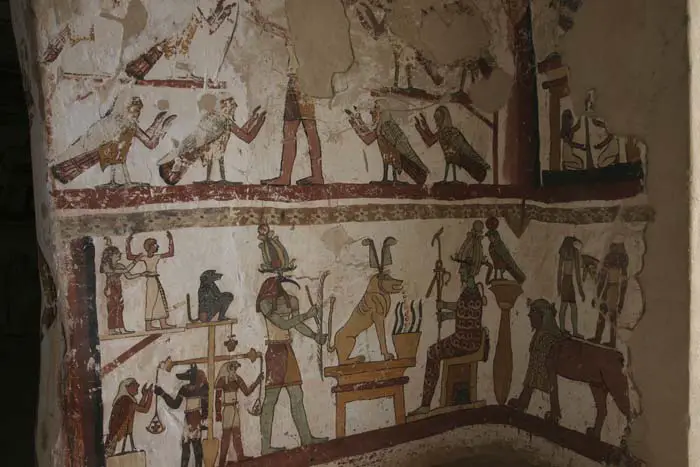
© isawnyu - Tomb wall paintings, depicting the weighing of the heart
Famous Marriages in Ancient Egypt
Royal marriages in ancient Egypt usually occurred between family members. Although the ancient Egyptians thought that this would preserve the purity of the royal lineage, it didn't. The result was genetic corruption and many royal babies didn't survive. Cleopatra married both of her brothers, Ptolemy XIII and Ptolemy XIV. Neither of the marriages produced offspring.
Tutankhamun and Ankhesenamun
The marriage of Tutankhamun and Ankhesenamun is perhaps one of the most famous in ancient Egypt. Ankhesenamun was King Tutankhamun's half-sister and his Great Royal Wife, they were married when he was about 10 years old and she was between 8 and 10 years old. Some historians postulate that she was first married to her father Akhenaten, but this has not been definitely proven.
Ankhesenamun was King Tut's only wife and their marriage is thought to have produced two daughters, both of whom were stillborn. Contrary to ancient Egyptian opinion, this didn't keep the bloodline pure. Rather, it resulted in genetic defects that were sometimes fatal. Some of King Tut's deformities were probably due to the fact that his parents were also brother and sister.
King Tut and his half-sister appear to have been very happy. Many images have survived that depict them in proximity, smiling at each other and proffering flowers or gifts.
Their marriage was short lived, since King Tut died when he was about 18 years old; he left no heir. Queen Ankhesenamun continued as Queen of Egypt but needed to find a consort. It isn't well documented, but some historians think she married Ay, a successor to King Tut and died during or shortly after his reign.

© Asaf Braverman - Tutankhamun and Ankhesenamun
Ramses II and Nefertari
Ramses II, known today as Ramses the Great, and first his wife, Nefertari, known today as the Great Royal Wife of Ramses II, were married during the first year of his reign. She was beautiful and well educated, which was unusual for women of her time. Ramses' esteem for her is evident in the lavishness of her tomb, and the fact that he constructed a temple for her that was next to his colossal temple in Abu Simbel.
Nefertari was very active in Ramses' court, serving both as a diplomat and as a royal correspondent. Her lineage is unclear but a cartouche of Pharaoh Ay indicates that she may be a distant relative of his. Nefertari had four sons and two daughters with Ramses, and she was prominent in Ramses' court for more than two decades. After about 25 years, her health apparently failed and she was buried in her lavish tomb in the Valley of the Queens.
Ramses II and Nefertari appeared to have a happy and long-lasting marriage. Ramses II had eight royal wives, but Nefertari appears to have been his favorite and remained his Great Royal Wife.
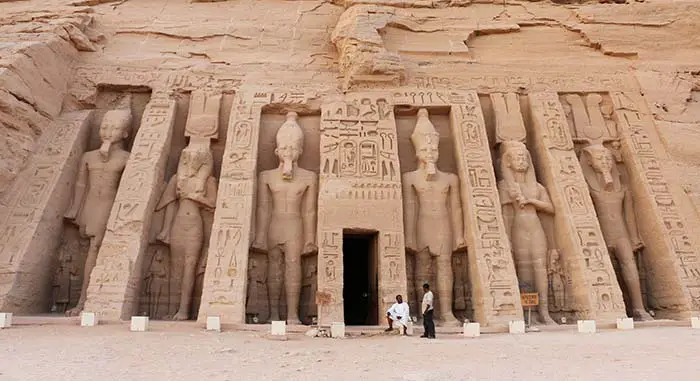
© Terry Feuerborn - Statues of Ramses II and Nefertari at Abu Simbel
Akhenaten and Nefertiti
In the fifth year of his reign, Pharaoh Amenhotep IV changed his name to Akhenaten, in keeping with the change from polytheism to monotheism, which he and and his Great Royal Wife Nefertiti decreed to their subjects. Akhenaten apparently had very high regard for his Great Royal Wife, as she wielded far more power than any of her predecessors. Nefertiti may have risen to the post of co-regent according to one of the stela, and she had numerous titles.
The pair reigned for 17 years until Akhenaten's death. Nefertiti's tomb has never been located, although it was customary for the pharaoh to provide burial accommodations for their Great Royal Wives.

© Ivan Herman - Sculptures of Akhenaten and Nefertiti
Facts about Marriage in Ancient Egypt
- Ancient Egyptians considered marriage to be the most desirable state and was intended to be monogamous, except for royalty. However, there's very little evidence that legal documentation was required other than the marriage contract.
- Before the 26th Dynasty, which was from 664 to 332 BC, women usually had little or no input in their choice of husbands. A man and the bride's parents determined whether the marriage would take place.
- Marriages couldn't take place between close relatives, except for royalty. Husbands and wives couldn't be related closer than distant cousins.
- Marriage between older men and very young girls was very common.
- Early dowries from the husband to the wife's parents were about equivalent to the price of a slave.
- If a husband divorced his wife, she was automatically entitled to about one-third of his money for spousal support.
- Despite the arranged marriages, statues and portraits usually depict happy couples.
